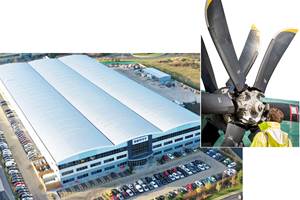GE Haliade-X 12 MW turbine blade delivered for testing
The 107-meter offshore wind blade will undergo fatigue testing at the Massachusetts Clean Energy Center’s Wind Technology Testing Center in Boston.

Source | GE
A blade from GE Renewable Energy’s (Paris, France) Haliade-X 12 MW offshore wind turbine has been delivered to the Massachusetts Clean Energy Center (MassCEC, Boston, Mass., U.S.), where it will undergo a series of fatigue tests over the next several months. The tests, taking place at the MassCEC’s Wind Technology Testing Center (WTTC), will involve the 107-meter blade moving millions of times to validate whether it can withstand more than 25 years of operation at sea.
The Haliade-X turbine is expected to be fully commercialized by 2021.

Source | GE
“This has really been a collaborative effort on the part of the company to be part of solving the challenges associated with the energy transition,” says H. Lawrence Culp, Jr, GE chairman and CEO. “We think the Haliade-X is the right turbine at the right time as the offshore industry globally and particularly here in the U.S. is poised to take off. We're proud Boston is part of this effort, and we appreciate the work the Commonwealth has put forth in laying out the roadmap by which Massachusetts can be a leading developer and user of offshore wind technology.”
“We believe the Haliade-X has a key role to play in driving the growth of the offshore wind market in the U.S. and globally. Because it is the most powerful machine in the industry, it allows our customers to drive down the cost of wind energy and speed the adoption of clean, renewable energy. We look forward to working with our partners at the Massachusetts Clean Energy Center’s WTTC to put the blade through rigorous testing that will help ensure that it will perform as designed,” says John Lavelle, CEO of GE Renewable Energy’s offshore wind business.

Source | GE
On Oct. 22, the U.S. Department of Energy announced new awards to support wind energy research, development and demonstration projects, which included a grant to MassCEC for equipment upgrades at the WTTC to enable structural testing of 85 to 120-meter long blades.
According to MassCEC, the WTTC currently offers a full suite of certification tests for turbine blade sections up to 90 meters in length. Since opening in 2011, WTTC has run 35 distinct blade testing programs including hundreds of individual blade tests. WTTC is an ISO/IEC 17025 accredited Laboratory and a RETL (Renewable Energy Testing Laboratory) per the IECRE rules and procedures to test wind turbine blades.
“Massachusetts is proud to have an important piece of infrastructure in the Wind Technology Testing Center that provides the offshore wind industry with an essential tool for groundbreaking innovations in technology,” says Energy and Environmental Affairs Secretary Kathleen Theoharides. “As the only location in North America to offer blade testing and certification at this size and scale, [Massachusetts] looks forward to continued collaboration with wind turbine developers to help this industry meet its full potential in the U.S. market.”
“Offshore wind represents an important energy source as [Massachusetts] works to meet ambitious greenhouse gas reduction targets, and we look forward to working with the industry to drive down costs, improve efficiency and develop of a hub of activity here in Massachusetts,” says Charlie Baker, governor of Massachusetts.
GE Renewable Energy also recently announced that the company has been selected as the preferred turbine supplier by Ørsted and the owners of the Dogger Bank Wind Farm to provide the Haliade-X for 4.8 gigwatts of projects in the U.S. and the U.K.
Related Content
ASCEND program update: Designing next-gen, high-rate auto and aerospace composites
GKN Aerospace, McLaren Automotive and U.K.-based partners share goals and progress aiming at high-rate, Industry 4.0-enabled, sustainable materials and processes.
Read MorePlant tour: Dowty Propellers, Gloucester, U.K.
Transforming decades of design and RTM production reliability into more sustainable, next-generation composite propellers.
Read MoreCarbon fiber in pressure vessels for hydrogen
The emerging H2 economy drives tank development for aircraft, ships and gas transport.
Read MoreMaterials & Processes: Resin matrices for composites
The matrix binds the fiber reinforcement, gives the composite component its shape and determines its surface quality. A composite matrix may be a polymer, ceramic, metal or carbon. Here’s a guide to selection.
Read MoreRead Next
From the CW Archives: The tale of the thermoplastic cryotank
In 2006, guest columnist Bob Hartunian related the story of his efforts two decades prior, while at McDonnell Douglas, to develop a thermoplastic composite crytank for hydrogen storage. He learned a lot of lessons.
Read MoreComposites end markets: Energy (2024)
Composites are used widely in oil/gas, wind and other renewable energy applications. Despite market challenges, growth potential and innovation for composites continue.
Read MoreCW’s 2024 Top Shops survey offers new approach to benchmarking
Respondents that complete the survey by April 30, 2024, have the chance to be recognized as an honoree.
Read More
.jpg;width=70;height=70;mode=crop)
























